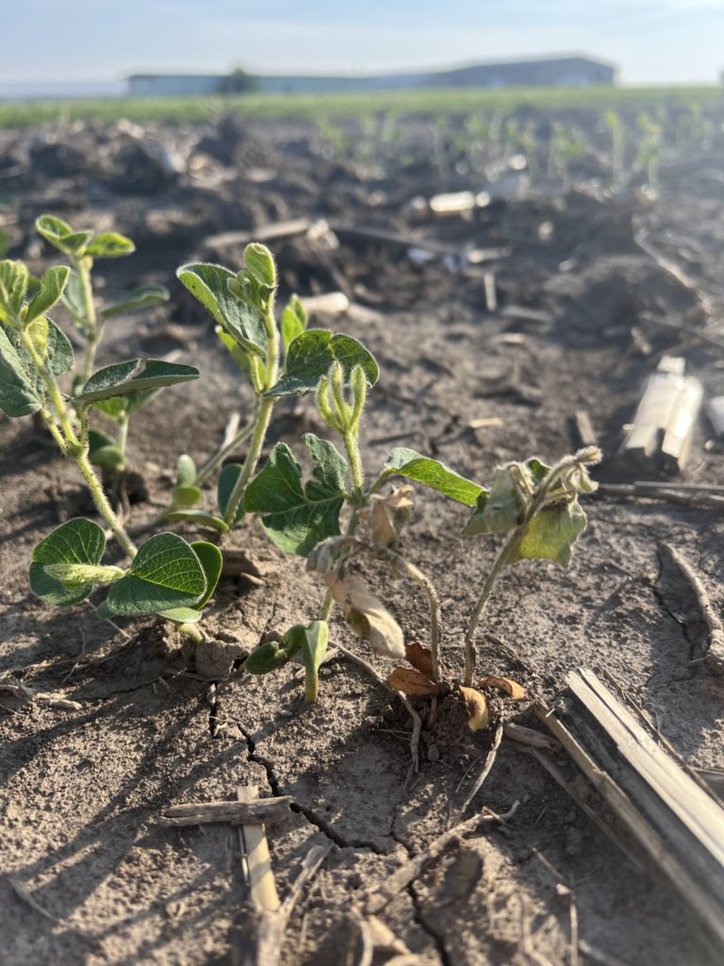Warning: This is not your typical soybean seedling blight blog. I am not going to list out all the soybean diseases, their symptoms, and the conditions in which they appear. Let’s move past that and dig deeper. Some farmers may not prioritize or find time to investigate why their soybeans may have died in a patch or in a certain area of a field. They replant and move on. In other instances, farmers know that they have a patch or area that dies in certain years and in certain field conditions, but what if it just keeps coming back?
Field History
Some farmers, perhaps with the help of an agronomist or a consultant, have gone the extra mile to try to figure out why “seedling blight” keeps happening. You can get a disease diagnosis by sending a plant sample off to the U of I Plant Clinic or another plant diagnostic clinic. For the sake of this blog, let’s assume that your soybean sample was diagnosed with pythium or phytophthora. Both can cause similar seedling blight symptoms before the V2 soybean growth stage and in all actuality, there could be several things going wrong (drainage, compaction, poor quality seed, planting depth), but this gives you the start you need to keep investigating further.
Seed Treatment Efficacy
Most would think that if you put a seed treatment on the soybean seed, it should be protected. In most cases, if your soybean consists of a seed treatment, it will consist of one to several fungicide components. What are they and why does it matter? Seed treatment packages or mixes can consist of different fungicide components that control different fungal species.
The North Central Regional Committee on Soybean Diseases has worked their tails off to develop ratings for how well each fungicide active ingredient (Ai) controls soybean seedling diseases by field testing them over multiple years and locations, and by summarizing ratings from across the U.S. If you check out the Fungicide Efficacy for Control of Soybean Seedling Diseases, you can see that fungicide Ai such as Ethaboxam, Mefenoxam, and Metalaxyl are rated Excellent (E) for Pythium spp. and Phytophthora spp. Oxathiapiprolin is also rated E for just Phytophthora spp.
Fungicide Resistance (Pythium)
Unfortunately, some areas have been found to have mefenoxam or metalaxyl “insensitive populations” of pythium. This means that a farmer might see less efficacy of these fungicide Ai if the pythium spp. in their field is less or no longer sensitive to mefenoxam or metalaxyl. Remember that the proper rate may also matter too when it comes to seed treatment efficacy and seed treatment only lasts so long depending on the Ai, field conditions, weather and more.
Soybean Disease Resistance (Phytophthora)
The good news is that using soybean varieties with genetic resistance is the most effective way to manage Phytophthora root and stem rot of soybeans. There are two different types of genetic resistance:
- Single-gene or Rps (Resistance to Phytophthora sojae) genes are race specific genes that offer complete resistance to a specific race of sojae. The genes are called Rps 1a, 1b, 1c, 1d, 1k, 3, 6, and 7 or a combination of one or more Rps genes. This race-specific resistance is effective in the early stages of soybean germination.
- Partial resistance or field tolerance; however, partial resistance alone will not be as effective in early soybean growth stages or under high disease pressure. Check out your soybean seed guide for Phytophthora ratings and ask your seed rep for more information if needed.
The bad news is that Phytophthora is known to adapt to Rps genes of soybean varieties, this is why you should identify the causal disease pathogen and check on those dead patches each year. There is always the chance that a new pathotype of Phytophthora has made a home in your field and yes, seed companies will need to adapt to these Phytophthora population changes. You may need to switch to a soybean variety with a new Rps gene stack.
Sources:





 and then
and then